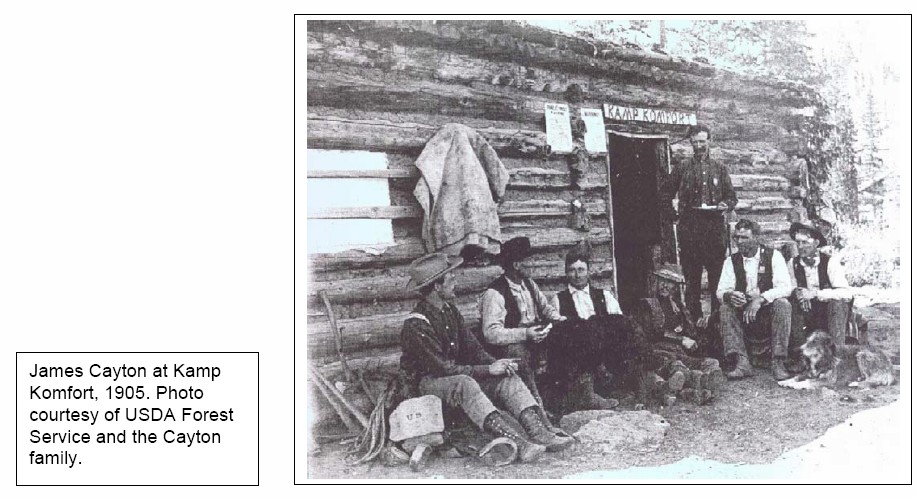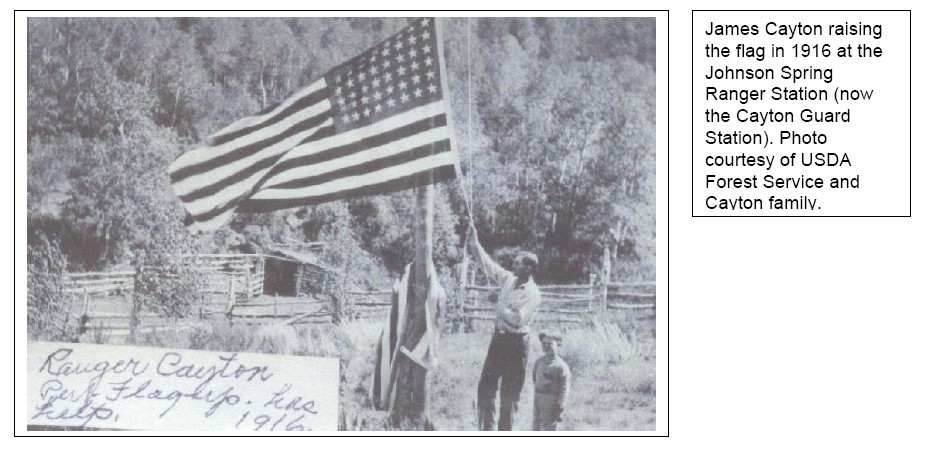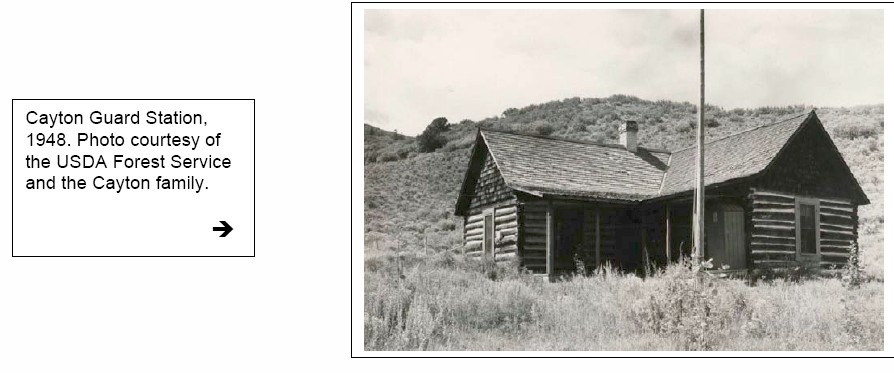Elizabeth (Grimshaw) & James Cayton
Originally from Cockerham, Lancashire, and Immigrants to Nebraska

James (Son of Elizabeth and James) and Amanda (Clark) Cayton (Presumed)
(Note: Webpage in preparation)
Contents
Webpage Credits
None yet.
Descendant Chart for Elizabeth Grimshaw
John Grimshaw (ca 1782, Manchester, England – ?) & Jane?
|—Elizabeth Grimshaw* (ca 1808, Manchester, England – ?) & William Roe or Wroe. Married 22 Nov 1823
|—|—Mary Roe (1824, Manchester – ?) [Adopted by Cayton]
|—|—Elizabeth Roe (6 Oct 1824, Manchester – ?) [Adopted by Cayton]
|—Elizabeth Grimshaw* (ca 1808, Manchester, England – ?) & James Cayton (ca 1800, Manchester, England). Married 8 October 1834, Cockerham, England.
|—|—James Grimshaw Cayton (4 Jun 1836, Cockerham – 30 Aug 1912, Mesa, CO) & Almeda
Clark (5 Jun 1843, Ohio – 21 Apr 1925, Steamboat Springs, CO). Married 8 Mar 1864, Nebraska.|—|—|—Fannie Elizabeth Cayton (12 May 1865, Fremont, NE – 2 Feb 1867)
|—|—|—Mary Abigail Cayton (27 Dec 1866, Hooper, NE – ?) & James Arthur Forbes (ca 1862, – ?). Married 1 Feb 1886 in Hooper, NE.
|—|—|—Edward Clark Cayton (30 Aug 1868, Logan, NE – 1 May 1946, Salt Lake City, UT)
|—|—|—Annabel Cayton (28 Jan 1870, Hooper, NE – 5 Feb 1903, Star, ID) & Charles Luther Barber (31 Dec 1867, Brookfield, MO – 16 Oct 1946, Oakland, CA). Married 20 Aug 1892.
|—|—|—Bessie Cayton (17 May 1872, Hooper, NE – 30 Jun 1962, Downey, CA)
|—|—|—Alice Jeanette Cayton (10 Oct 1874, Hooper, NE – 13 May 1949, Steamboat Springs, CO)
|—|—|—Emmeline Cayton (19 Feb 1877, Hooper, NE – 20 Apr 1944, Sacramento, CA) & Charles Daniel Ross (1873 – ?). Married 17 Jun 1900.
|—|—|—James Grimshaw Cayton, Jr. (8 Oct 1878, Hooper, NE – 27 Apr 1956, Rifle, CO) & Adelaide Dorthea Miller (ca 1888, Glenwood Springs, CO – ?). Married 7 Sep 1909, Glenwood Springs, CO.
|—|—|—Elsie Cayton (21 May 1883, Fullerton, NE – 20 Apr 1885)
|—|—John Cayton (15 Sep 1837, Manchester – 3 Jul 1875?)
Immigration Record
They (James and Elizabeth) immigrated to the US on the Ship, NEW WORLD, arriving in New York, Sept 27 1850.
Source: http://archiver.rootsweb.com/th/read/GRIMSHAW/2006-09/1157355868
Minibiography
Mini Biography
Fannie Elizabeth Cayton, infant daughter of James Grimshaw Cayton and Almeda Clark Cayton, is buried at Logan cemetery. Fannie was born on May 12, 1865 and died on July 2, 1867. Jas. Cayton was Justice of the Peace at Logan Creek. Information from Norm Nicholson, of England, states that James Grimshaw Cayton was born in Lancashire, England on 6-4-1836 and died at Mesa, CO on 8-30-1912. His wife, Almeda Clark, was born on 6-5 1843 in Ohio and died on 4-21-1925 at Steamboat Springs, CO. Their other children were Mary Abigail Cayton 1867-1958, Edward Cayton 1868-1946 and Annabel Cayton Barber 1870-1903. No additional information was found.
The 1870 US Census for Logan Creek, Dodge County, Nebraska show:
|
Name
|
Age
|
|
|
|
Birth
|
|
Cayton,
|
34
|
m
|
w
|
Farmer
|
England
|
|
Almeda
|
27
|
f
|
w
|
|
Ohio
|
|
Abagal
|
3
|
f
|
w
|
|
Nebraska
|
|
Edward
|
2
|
m
|
w
|
|
Nebraska
|
|
Annelula
|
4/12
|
f
|
w
|
|
Nebraska
|
Source: http://freepages.genealogy.rootsweb.com/~logancem/loganweb2.htm
Photo Believed to Be of James and Amanda (Clark) Grimshaw and Family
All girls except the oldest and youngest. Two oldest daughters probably absent; boys are likely Edward and James Grimshaw, Jr. Young James would be the future U.S. Forest Ranger described below.
Source: http://freepages.genealogy.rootsweb.com/~logancem/loganweb2.htm
“Note: Norm Nicholson sent this photo to me on January 11, 2003.“
Packet Ship New World
Swallow Tail Line Packet New World in Liverpool
From the original photograph belonging to Mrs. Dora E. Chamberlain, whose husband, Captain James H. Chamberlain, long served aboard the ship. Certainly this is one of the first photographs of a tall ship ever taken.
Source: http://www.dennyhatch.com/jackcorbett/doc/illustrations.html
PAF7739 United States Packet Ship New World 1404 tons register. Built at Boston, Mass. 1846 by Donald McKay
Source: http://www.nmm.ac.uk/collections/prints/viewPrint.cfm?ID=PAF7739
Ships built by John McKay
1842 Courier, trading ship, 380 tons. 1843 St. George, packet ship, 845 tons. 1844 John R. Skiddy, packet ship, 930 tons. 1844 Joshua Bates, packet ship, 620 tons. 1845 September 15 Washington Irving, packet ship, 751 tons. 1846 September 5 Anglo Saxon, packet ship, 894 tons. 1846 September 9 New World, packet ship, 1404 tons. 1847 July Ocean Monarch, packet ship, 1301 tons.Source: http://www.globalindex.com/clippers/museum/d_mckay_.htm
James Grimshaw Cayton, Jr, Early U.S. Forest Ranger in Colorado
Grandson of Elizabeth and James Cayton, the immigrants.
Click here for registration form for National Register of Historic Places, 8 November 2004.
Click here for Forest Conservancy News (Summer/Fall 2006) and look on page 3, column 2.
Photos from above two resources shown below News Release that follows.
News Release
2005
USDA Forest Service
Rocky Mountain Region
White River National Forest
Cayton Cabin
Within rough spruce cabin walls lie the legacies of early forest ranger James Cayton, the young National Forest he sought to protect and the people he served.
The Cayton Guard Station lies on the edge of the White River National Forest near in the Divide Creek area near Silt, Colo. It is one of the oldest ranger stations in the U.S. It was the administrative post for James Cayton, one of the original Forest Rangers.
The story of the guard station is “just begging to be shared,” said Forest Service archaeologist Andrea Brogan. The guard station symbolizes the history of the Forest Service, Colorado and the westward movement, said Dave Cayton, grand-nephew of James Cayton.
James and Adelaide “Birdie” Cayton finished building the log cabin by hand in 1910. The station was named the Johnson Spring Guard Station until it was later named in James Caytons honor. Birdie was a teacher at Fairview School near Silt and a daughter of a local rancher.
“They had no big machinery, no big crews,” Dave said. “They lived in a tent and worked together, shoulder to shoulder, to build the three room log cabin.”
As an early Forest Ranger, James administered grazing permits, distributed fish and game licenses and fought wildfires among his duties on what was then the Battlement National Forest.
“He would head out on his horse and [with] his tent,” Dave said. “Wherever he was at nightfall, he camped. Hed often be gone for several days.” His pencil and ink cursive trailing along the pages of his journals tells of interactions with ranching families, some whose descendents are still in the area.
Frank M. Starbuck is a rancher whose roots are intertwined with the Cayton story. Starbucks father homesteaded on Divide Creek, about three miles from the Guard Station. He received one of the first permits to graze cattle and horses on the White River National Forest.
Starbuck rode with James, stayed at the Guard Station and had meals with the Caytons. Starbuck also attended business meetings between The Forest Service and permittees at the station.
James was friendly, “but Jim was firm, he didnt talk much,” Starbuck said.
In 1919, James and Birdie moved to California. When they returned to Colorado in 1921, James became the District Ranger on the Rico District of the San Juan National Forest. A campground there is named in his honor. James retired from the Forest Service in 1939 and moved from Rico to Rifle.
When James and Birdie moved to Rifle, they lived in the building that is now Karyletts Country Store on East Avenue and James became the Justice of the Peace. James lived in Rifle until his death in 1956.
Fast forward nearly five decades to June 2004.
After more than10 years of research and seeking funds, the Forest Service completed a historic assessment through an architectural contract. The structural integrity of the guard station and critically needed repairs were described, including stabilizing the foundation.
Approximately $25,000 will cover the costs of critical repairs.
“Hopefully, well be able to do some of the critical repairs next July,” Brogan said.
Other repairs will be completed as they are funded.
“Restorations going to be done in stages,” said Rifle District Ranger Dave Silvieus.
The Forest Service is nominating the Cayton Guard Station for listing on the National Register of Historic Places. Listing on the Register means that a site is eligible for federal funds and recognition of its historical significance to the nation, state or community.
The site is an excellent candidate for the historic register because of its incredible shape, original setting and its construction during a critical era of Forest Service history under President Theodore Roosevelt, according to Brogan.
The Forest Service will learn if the site is accepted for listing on the National Historic Register by February 2005, the same year the Forest Service and the town of Rifle will celebrate their centennial years.
The Cayton Guard Station restoration project also will be a significant part of the White River National Forests year-long centennial celebration, “New Century of Service.”
“The Cayton Guard Station will be the New Century of Service centerpiece because it embodies Forest Service history,” Silvieus said. “Cayton was the first ranger on one of the first national forests.”
Once the building is restored, user opportunities abound.
“Its really critical that a building is lived in,” Brogan said. “It keeps it alive.”
There are several trails near the station, including the Sunlight to Powderhorn trail, a groomed snowmobile trail. Cross-country skiing potential lies in the surrounding area and the cabin could be rented to horseback riders or hunters.
The station could also be a meeting center or a place to get away from busy city life.
“Theres a ton of potential for the station,” Silvieus said.
Dave said the cabin should not be an untouched relic behind a chain link fence, but an interactive historic legacy and that makes “you feel like youre at a Ranger Station in 1910.”
The Forest Service has several partners in the Cayton project.
“Weve got wonderful partners, both in service and externally,” Brogan said.
The Colorado Historical Society and Silt Historical Society helped fund the project, and Dave Cayton wrote grants as well as contributed family history.
“Dave Cayton was responsible for instigating the project and pulling it together,” Brogan said. Birdie Cayton donated her personal collection of documents and photographs spanning 1908 to 1968. The collection includes historical photos, letters, diaries, newspaper clippings and maps which relate to the Forest Service, the Cayton and Miller families and Colorado and U.S. History. These records are part of the National Historic Register application and some may be displayed in the restored cabin. For now, they are being kept at the Rifle District Ranger Office.
The White River Interpretive Association or WRIA will handle donations for the project.
“We are well on our way to celebrating this place and sharing it with the community,” Brogan said.
If you have story to share about James or the station or want to help with funds, contact WRIA Director Marcia Johnson at (970) 963-8071.
More centennial celebrations on the White River National Forest!
Source: http://www.fs.fed.us/r2/whiteriver/news/2005/cayton_cabin.shtml








Webpage History
Webpage posted November 2007.










